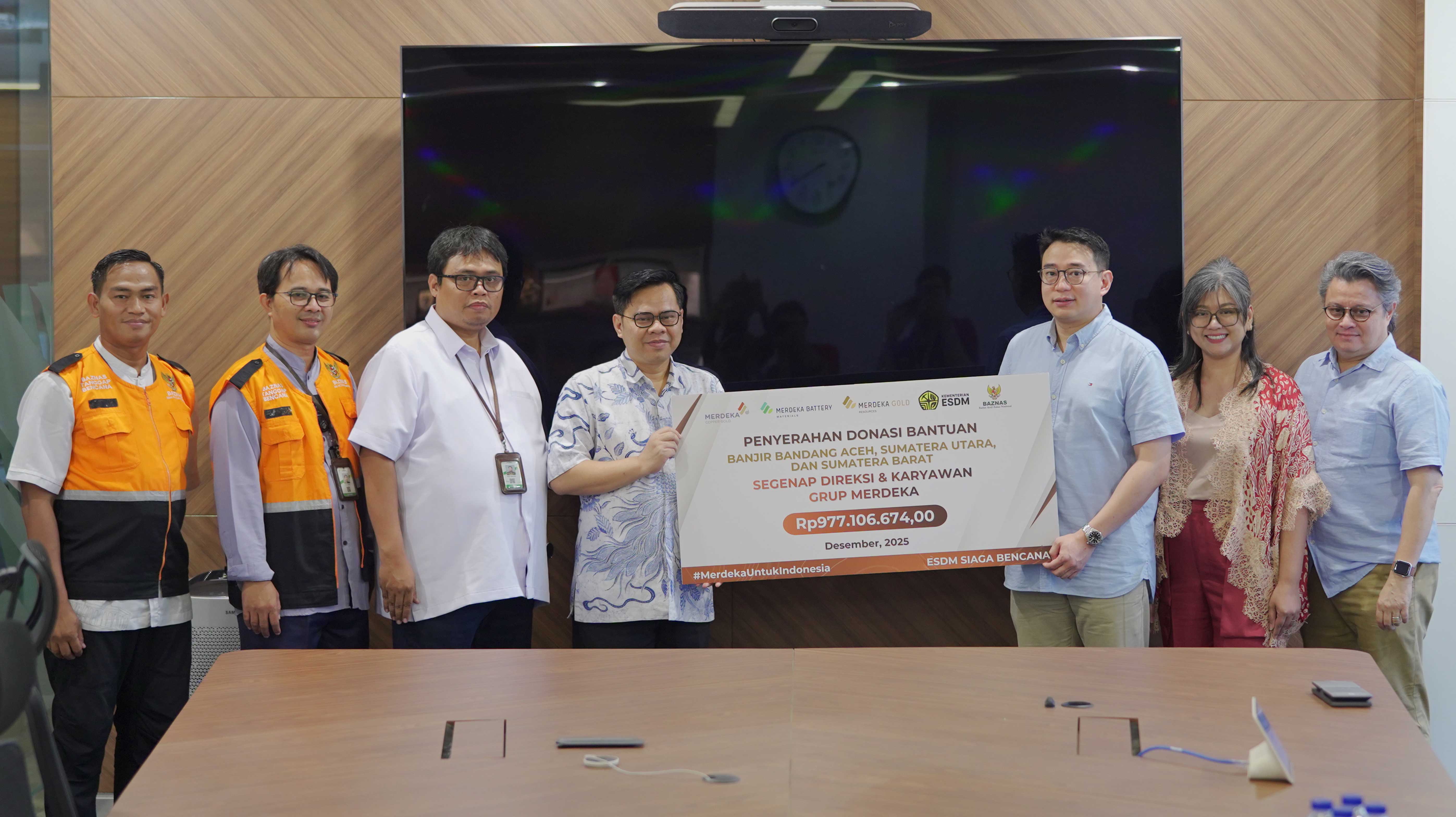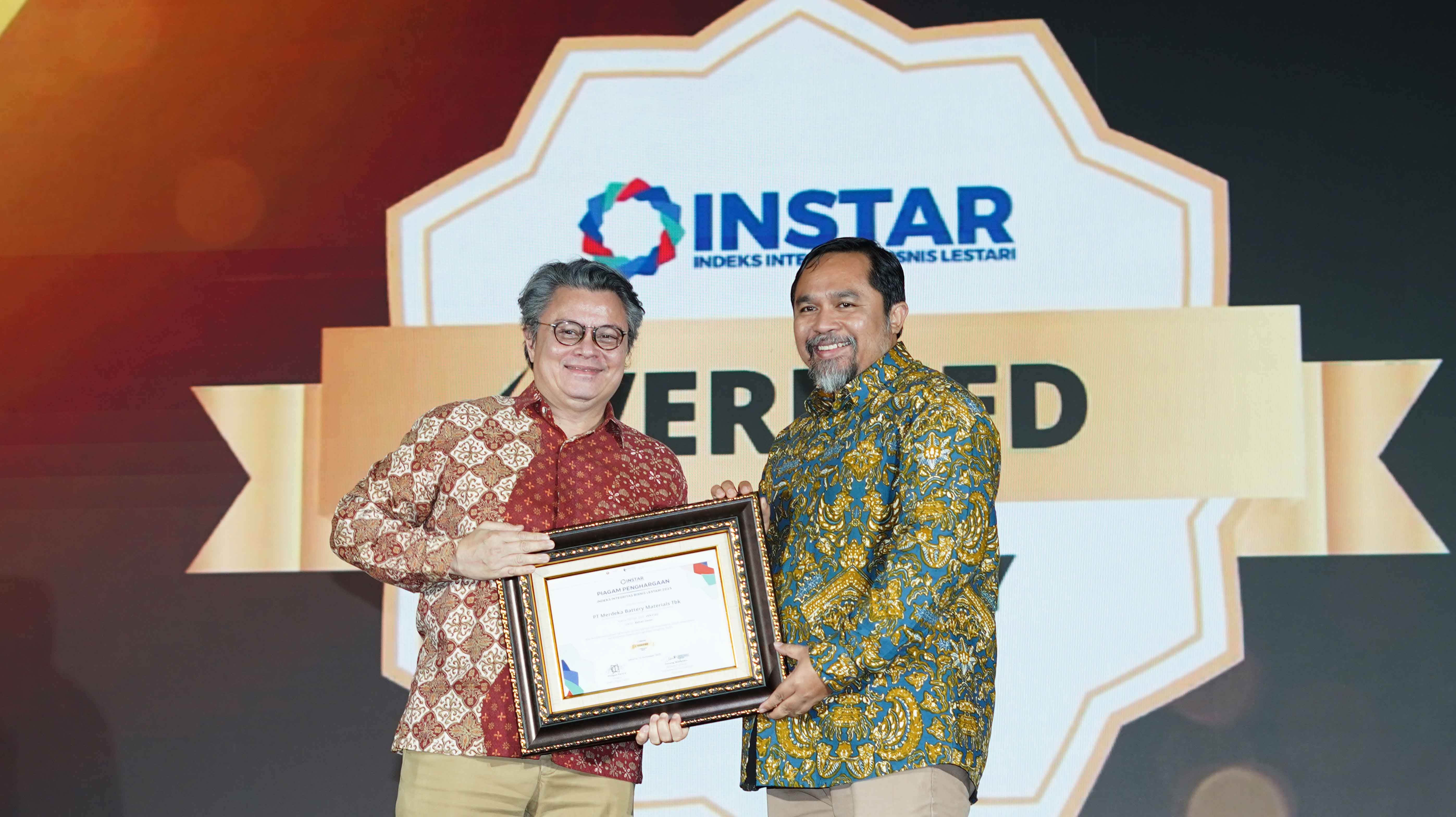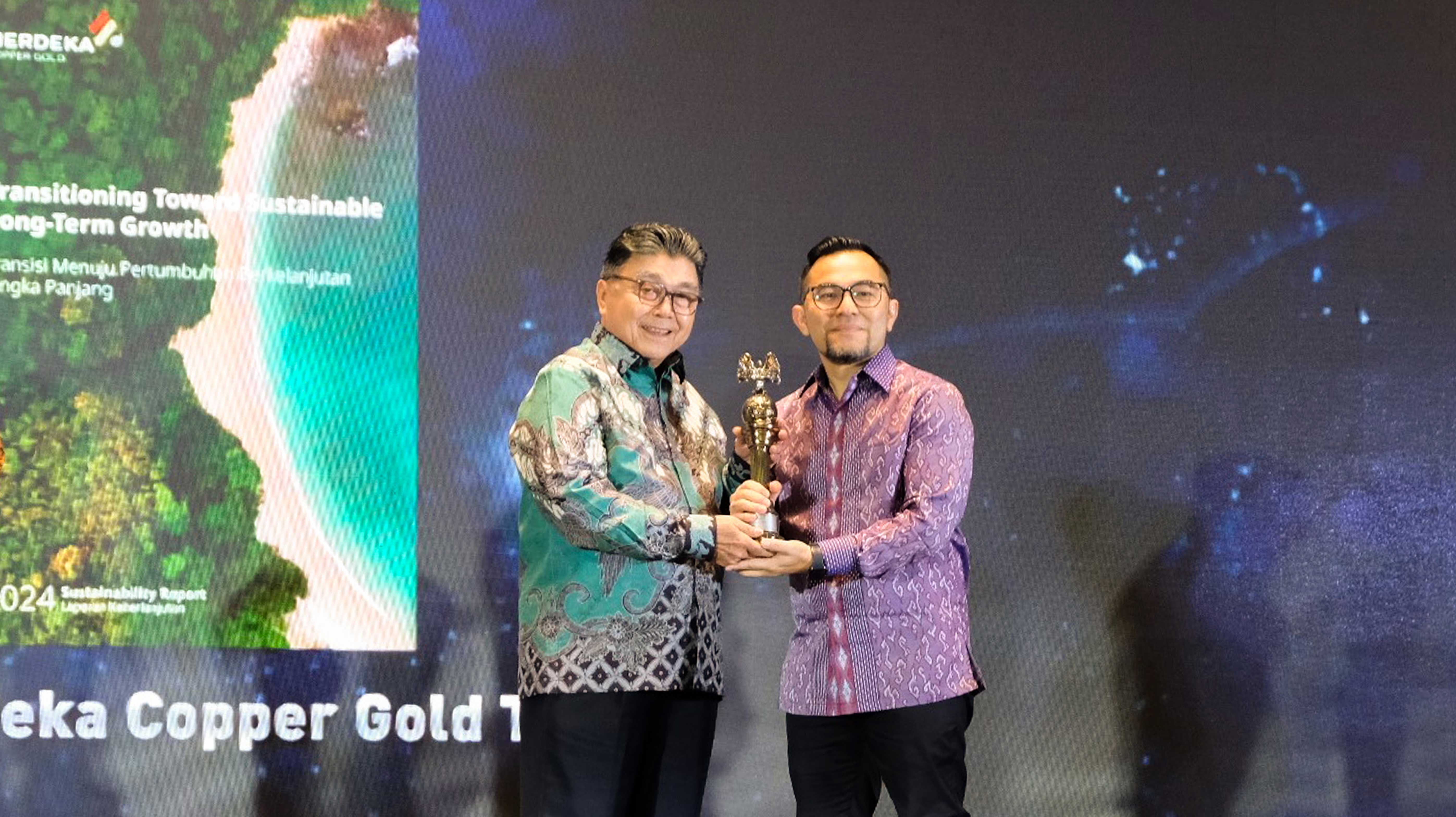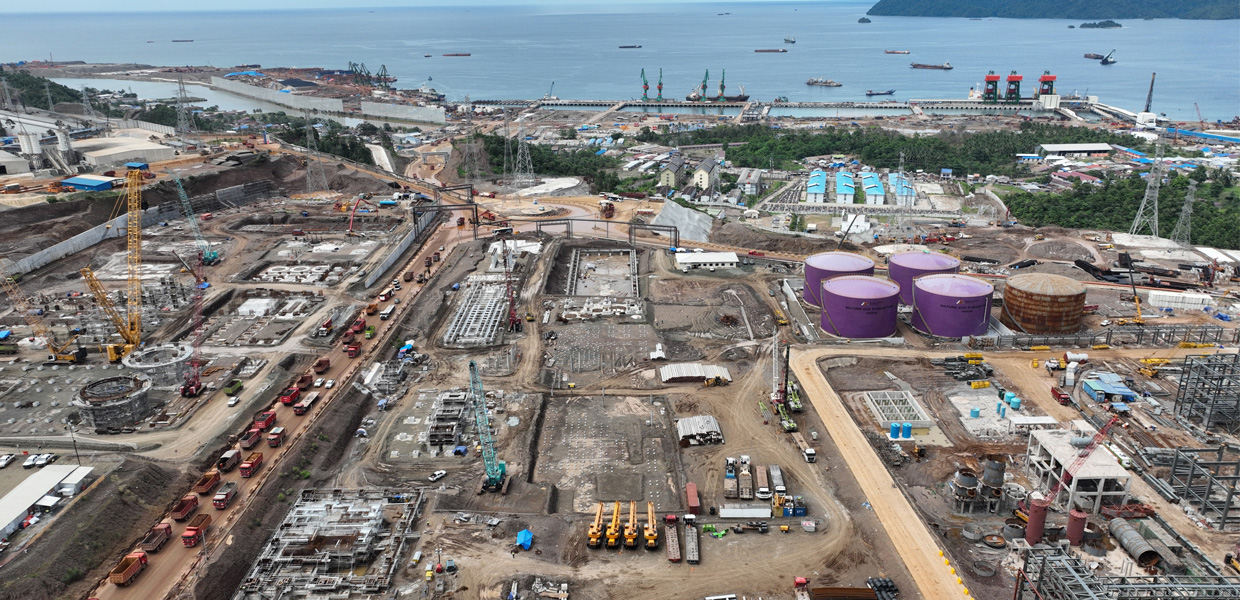
Responding to Future Challenges with Clean Energy
Clean energy will become an increasingly inevitable need. Merdeka answered this challenge, among others, by entering the battery industry.
There have been other activities besides the daily operations at the Wetar Copper Mine these last days. At one point on the Lurang coast, piles began to be planted for the construction of a special jetty that would later be used for shipping pyrite to Morowali, Central Sulawesi. Currently, considering that there are no routine shipments in large quantities, pyrite, which mostly comes from the Partolang area, is still stored specifically, for example, the stockpile is covered with a liner (tarpaulin) to keep it free from acidic liquids.
Pyrite, also known as iron pyrite or pseudo gold, is the most common mineral of the sulfide group of minerals. Its metallic luster and pale yellow color resembles that of gold at a glance—that’s where the name pseudo gold comes from. In the past, pyrite was widely used as an ignition source in firearms. In modern times, this mineral is widely used for the paper industry, sulfuric acid raw material, and cathode in lithium batteries—well, it is related to batteries or green energy that Merdeka Copper Gold has built a special jetty in Wetar.
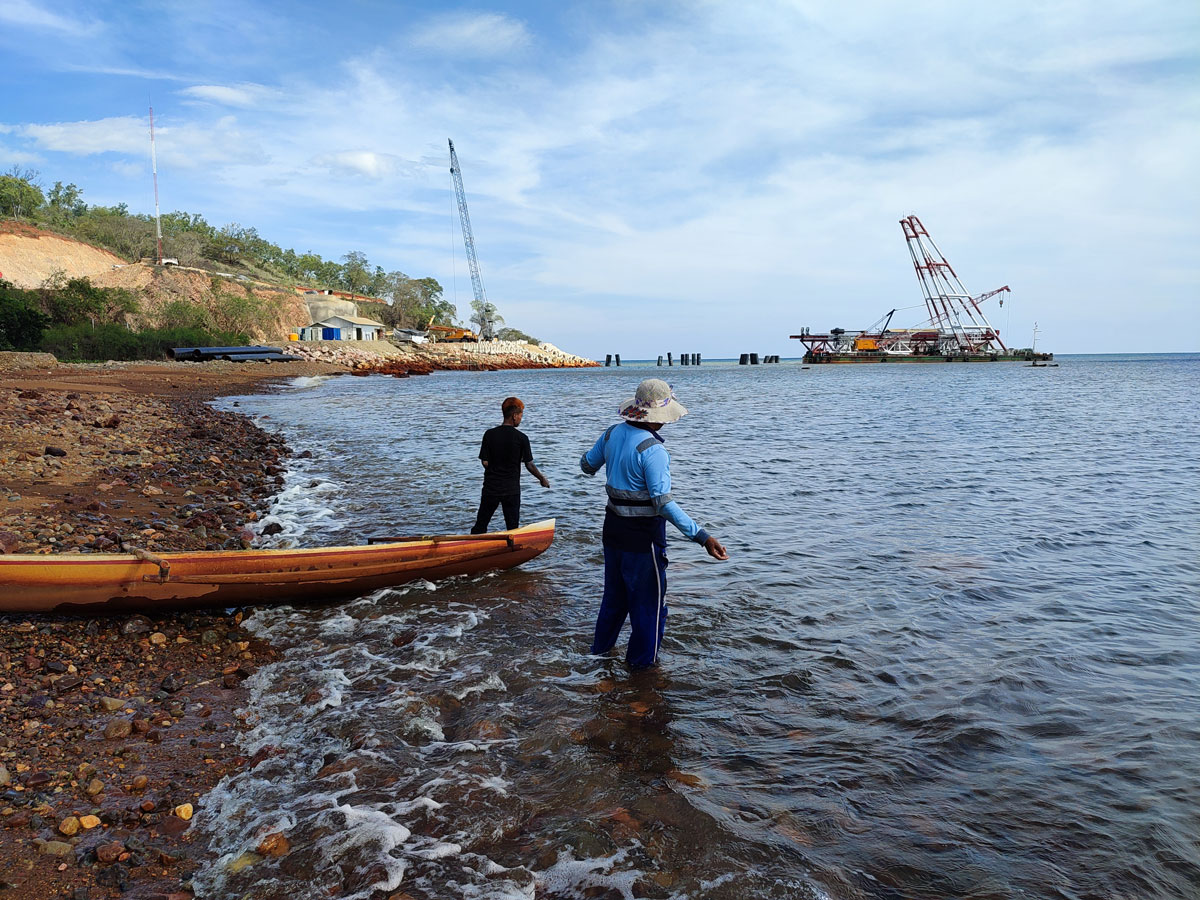
Currently, MTI is under construction at the Indonesia Morowali Industrial Park (IMIP). IMIP itself is a complex consisting of various factories that will be the consumers of most of the mineral content extracted by MTI. For the AIM Project, Merdeka has invested around US$300 million to take care of the licensing and establishment of the MTI factory, as well as the construction of a special port in Wetar. MTI is targeted to start production in 2023 and is expected to generate US$170 million per year for more than 20 years.
According to Albert Saputro, President Director of Merdeka Copper Gold, Merdeka’s business development is in line with what the company has been doing so far. “The principle is the same, we produce materials that contribute significantly to the progress of human civilization. Now, with the increasing demand for green energy, batteries will become an inevitable need, and Merdeka must be at the forefront to fulfill it,” said Albert.
Merdeka’s seriousness in developing the battery business can be seen with its latest steps. On May 17, 2022, Merdeka through one of its subsidiaries, namely Batutua Tambang Abadi (BTA) has purchased 55.67 percent of Hamparan Logistik Nusantara (HLN) shares with a total value of Rp5.4 trillion.
With this purchase, Merdeka has obtained Sulawesi Cahaya Mineral (SCM) holder of a 21,100 hectare Mining Business License (IUP) in Konawe Regency, Southeast Sulawesi Province which has the largest undeveloped nickel resource in the world; Cahaya Smelter Indonesia (CSI) and Bukit Smelter Indonesia (BSI), two Rotary Kiln & Electric Furnace (RKEF) nickel smelters operating and generating cash flows; Zhao Hui Nickel (ZHN), one of RKEF’s nickel smelters under construction; and Indonesia Konawe Industrial Park (IKIP), a joint venture nickel industrial area within the SCM IUP which is currently still in the planning and feasibility stages.
SCM is a low cost and low risk open pit mining operation. The location is near a downstream processing plant, about 50 km by road from IMIP. Roads are currently under construction so that SCM saprolite ore can be trucked to IMIP for processing at the CSI, BSI, and ZHN RKEF plants to produce nickel pig iron (NPI). The target for the production of saprolite ore is 7 million per year.
SCM will also supply limonite ore to the High Pressure Acid Leach (HPAL) plant at IMIP, namely the Huayue Nickel Cobalt (HNC) plant. In the future, HPAL is expected to be developed in IKIP which is located within the SCM IUP. HNC will build a pipeline linking the ore preparation plant at SCM to their HPAL at IMIP. Limonite is used in the production of Mixed Hydroxide Precipitate (MHP) which is used to manufacture batteries. Estimated ore supply is 6–8 metric tons per year of limonite ore from mid-2023.
CSI Smelter and BSI Smelter are jointly owned and operated with Tsingshan at IMIP. Both are fully operational and have a combined nameplate capacity of ~38,000 tonnes of nickel per year. Both the CSI and BSI smelters were built by Tsingshan in 2020. Tsingshan pioneered the development of the RKEF smelter. RKEF’s Tsingshan-linked RKEF smelter in Indonesia currently produces more than 500 thousand tons of Nickel per year. RKEF produces NPI which is used in the production of stainless steel—both for inside IMIP and for export.
Batteries are one of the clean energy alternatives whose needs are increasingly real today and in the future. Clean energy provides a variety of environmental and economic benefits, including the reduction of air pollution. Diversified clean energy supplies also reduce dependence on fossil fuels. Clean energy is also important for sustainable development because the development and use of renewable energy will improve energy security, the environment, the economy, mechanical manufacturing, construction, transportation, and industry, and help create new jobs.
In the context of responding to this challenge, Merdeka’s business development in the battery industry is not only acceptable but also a necessity. At the same time, on the operational side, Merdeka will also be more inclined to use green technology.
Merdeka has started on Pulau Wetar, the operational area of Batutua Kharisma Permai and Batutua Tembaga Raya (BKP-BTR). Since last January, on the hillside above the generator house, there are 600 solar modules divided into three columns. These modules have generated as much as 540 kWh of electricity into the On Grid system for the company’s operational needs. Thus, the site is no longer completely dependent on diesel generators.
Previously, at the end of 2021, BKP-BTR replaced all 18 old diesel generators with new generators that were 10 percent more efficient in fuel consumption. With this measure, greenhouse gas emissions are reduced by about 1,600 tons of CO2(e) per year. According to Merdeka’s CEO, Silmon Milroy, reducing carbon emissions is one of the company’s sustainability performance targets in line with Merdeka’s commitment to Clean Zero Emissions by 2050.
One of the important steps towards achieving the 2050 target is the establishment of Merdeka’s strategic partnership with Hong Kong Brunp CATL (Contemporary Amperex Technology Co., Limited) to invest in the battery metal supply chain in Indonesia. With the agreement signed by the two at the end of 2021, Brunp CATL plans to become a strategic investor in Merdeka with share ownership of up to 5 percent.
Hong Kong Brunp CATL, an affiliate of CATL, is a global leader in new energy technology innovation, committed to providing key solutions and services for new energy applications worldwide. According to SNE Research, in 2020, CATL EV battery consumption volume was ranked No. 1 in the world for four consecutive years. CATL is also widely recognized by its global original equipment manufacturing partners.
It is in this complementary strategic partnership in Indonesia that Merdeka and Brunp CATL are considering the establishment of an investment platform for investment in mineral resources for the battery metal value chain, such as nickel, cobalt, lithium, copper, manganese, and aluminum. The platform will also develop battery metal industrial estates and support green energy sources. The two will also proactively seek to engage in joint projects within the wider battery metal chain in Indonesia, to develop the electric vehicle and battery industry in Indonesia.
“We are very pleased to welcome CATL as a strategic investor in Merdeka. The metal battery supply chain has huge growth potential in Indonesia and is strongly supported by government policies. We are confident that we are partnering with the right group and that our partnership will significantly strengthen Merdeka’s focus and capabilities in this sector,” said Milroy.
What Merdeka has done is still in its early stages. However, as a company that has the vision to be at the forefront, this step is a must. The future is in sight.
